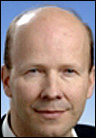Finnish wireless-technology firm Elektrobit debuted its first RFID products today at the ID World 2006 conference in Milan. The company says it aims to become a leading global provider of RFID reader systems.
Elektrobit has performed research and development for the RFID market for the past 10 years. To date, it says it has held back from launching any products because it believed the RFID market was developing too slowly. That, however, is no longer the case.
“We see a clear change in the market picture,” says J.T. Bergqvist, chairman of the board at Elektrobit and a former high-ranking official at Nokia. “With the standardization of UHF and EPC Gen 2, we see a major opportunity to enter the commercial RFID market after so many years in R&D services.”
According to Bergqvist, other problems—such as the scarcity of spectrum in Europe and the European Telecommunications Standards Institute (ETSI) “listen before talk” requirement (see Interrogators Designed for the European Set)—have made it difficult for companies to install UHF readers on a wide scale. ETSI is a nonprofit organization responsible for the standards development of information and communications technologies within the European Union (EU).
ETSI, as well as several RFID vendors and users, has been studying ways to facilitate large-scale UHF RFID deployment (see ETSI Tests Show EPC Scaleable in Europe). Elektrobit is a member of both ETSI and EPCglobal, an organization leading the development of industry-driven standards for the Electronic Product Code (EPC).
Elektrobit’s new Identification Network Architecture is designed to address all these problems, the company says, serving as an efficient tool for large RFID installations in Europe.
“We’re not only introducing a new reader,” Bergqvist explains. “We are also introducing a new concept called the Elektrobit Identification Network Architecture, that allows multiple readers to be installed in the same application, and synchronized so that the read rates and distances are maximized.” He adds: “We believe this is extremely important for the industry to go forward.”
The network architecture contains three elements. The first is an ETSI-compatible UHF reader that complies with the EPC Gen 2 and ISO 18000-6C standard and operates with a monostatic antenna. The second is a WLAN node compatible with the IEEE 802.11 (a, b, g) Wi-Fi standard. The node provides connectivity for mobile readers, functions as the backbone of the reader network and also supports wireless video and VoIP. The third element of the network architecture is the RFID Network Controller. The entire system uses software based on Elektrobit’s new Facility Sounding technology, enabling readers to avoid interference by synchronizing with each other.
Elektrobit’s Identification Network Architecture, guided by Facility Sounding software, lets readers listen to the transmissions of all other readers and store information about interfering signal strengths and radio-channel characteristics within the interrogator.
Hanspeter Sutter, Elektrobit’s director of RFID solutions, says, “Propagation of RF signals is an essential part of any wireless system. Readers must be able to scan their environment, and the network must be so clever that it knows what gate readers are installed, and what other kinds of readers are around. Then it must report all this information to a centralized controller.”
Although Elektrobit already has customers for its new products, the company has declined to release their names. It expects that the first large-scale pilots to move to commercial applications will be operated by industrial or logistics companies. Thus, it is targeting industrial customers in the telecommunications, automotive and electronics industries.
The interfaces for the network architecture are open, allowing readers from different manufacturers to work together with Elektrobit’s solution.


